
World Of Controls understands the criticality of your requirement and works towards reducing the lead time as much as possible.
DS3820RDMB1A - Advance Relay Drive Control Module is available in stock which ships the same day.
DS3820RDMB1A - Advance Relay Drive Control Module comes in UNUSED as well as REBUILT condition.
To avail our best deals for DS3820RDMB1A - Advance Relay Drive Control Module, contact us and we will get back to you within 24 hours.
SPECIFICATIONS:
Part Number: DS3820RDMB1A
Manufacturer: General Electric
Series: Mark IV
Product Type: Advance Relay Drive Control Module
Input Voltage: 24V DC
Memory Capacity: 128 MB RAM, 128 MB Flash
Processor Speed: 400 MHz
Operating Temperature: -20°C to +60°C
Signal Type: Digital pulse signals
Communication Interfaces: 2 Ethernet, 2 CANopen
Power Consumption: 30 W
Mounting Type: DIN rail
Dimensions: 173.2 mm x 101.6 mm x 76.2 mm
Repair: 3-7 Days
Availability: In Stock
Weight: 0.45 kg
Status: Discontinued by Manufacturer
Country of Origin: United States
FUNCTIONAL DESCRIPTION:
DS3820RDMB1A is an Advanced Relay Drive Control Module manufactured and designed by General Electric as part of the Mark IV Series used in GE Speedtronic Gas Turbine Control Systems. The primary function of the Advance Relay Drive Control Module is to send the necessary signals to activate or deactivate the relay, depending on the requirements of the system. This is crucial for systems where multiple relays must be controlled simultaneously, ensuring seamless operation and protection of the system. These features can include real-time monitoring, fault detection, and the ability to handle complex or high-voltage systems more effectively. For instance, advanced control modules might be capable of monitoring the status of the relays and providing feedback on their operational condition.
FUNCTIONS OF RELAY DRIVE CONTROL MODULE:
WOC has the largest stock of GE Speedtronic Control System Replacement Parts. We can also repair your faulty boards and supply unused and rebuilt boards backed up with a warranty. Our team of experts is available round the clock to support your OEM needs. Our team of experts at WOC is happy to assist you with any of your automation requirements. For pricing and availability on any parts and repairs, kindly contact our team by phone or email.
What is an Advance Relay Drive Control Module?
An Advance Relay Drive Control Module is an electronic component designed to manage and control relays within an electrical or automation system. It sends control signals to activate or deactivate relays, enabling the flow of electricity to different components in the system.
How does the Advance Relay Drive Control Module enhance safety?
The module includes built-in safety features such as overload protection, short-circuit protection, and thermal shutdown. These features prevent the relay or system from being damaged by excessive current, voltage, or temperature.
How does the module detect faults in the system?
The module monitors the operational conditions of the relays and connected components. It checks for issues like overheating, relay failure, or electrical faults. If any problems are detected, the module can alert the operator or take corrective action, such as shutting down the system to prevent damage.